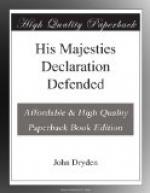specious names of Religion and Liberty.”
After these introductory paragraphs Dryden began to
reply to the pamphlet point by point. His method
is to quote or, more strictly, partly to quote and
partly to paraphrase, a sentence and then refute its
argument. In so doing he is following the method
of the author of A Letter. Accordingly,
to understand and judge the fairness of Dryden’s
refutation, it is well first to read His Majesties
Declaration, then A Letter, and finally
Dryden. The first has not been reprinted in full
but a substantial extract may be found in Echard’s
History of England (III, 624-6) and in Arthur
Bryant’s The Letters of Charles II (pp.
319-22), the second is available in a not uncommon
folio, State Tracts: being a Collection of
several Treatises ... privately printed in the Reign
of K. Charles II (1689), and the third is here
reproduced for the first time. After the perusal
of these three tracts, the student may well turn to
Absalom and Achitophel, and find instruction
in comparing the prose and the verse. He may reach
the conclusion that while both were written to win
converts to the royal cause, the first was designed
to weaken the Whig party and the second to take advantage
of a tide that had turned to ruin the Whig leaders.
(For a fuller discussion of the relationship of Dryden’s
tract and his poem see the writer’s article,
“The Conclusion of Dryden’s Absalom and
Achitophel” in the Huntington Library Quarterly,
X (1946-7), 69-82.) In addition to its historical
interest Dryden’s tract is a fine specimen of
his masculine, vigorous style so well suited to controversial
writing.
I desire to thank Mr. James M. Osborn, Yale University, for helpful suggestions in the preparation of this introduction.
This facsimile has been made from the copy in the William Andrews Clark Memorial Library.
Godfrey Davies The Huntington Library
His Majesties
DECLARATION
DEFENDED:
In a LETTER to a Friend.
BEING AN
ANSWER
TO A
Seditious Pamphlet,
CALLED
A LETTER from a Person of Quality to his Friend:
CONCERNING
The Kings late Declaration touching the Reasons which moved him to Dissolve
THE TWO LAST
PARLIAMENTS
AT
WESTMINSTER and OXFORD.
LONDON: Printed for T. Davies, 1681.
THE
Kings Declaration
DEFENDED.
Sir,




